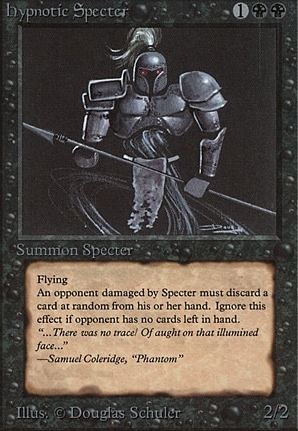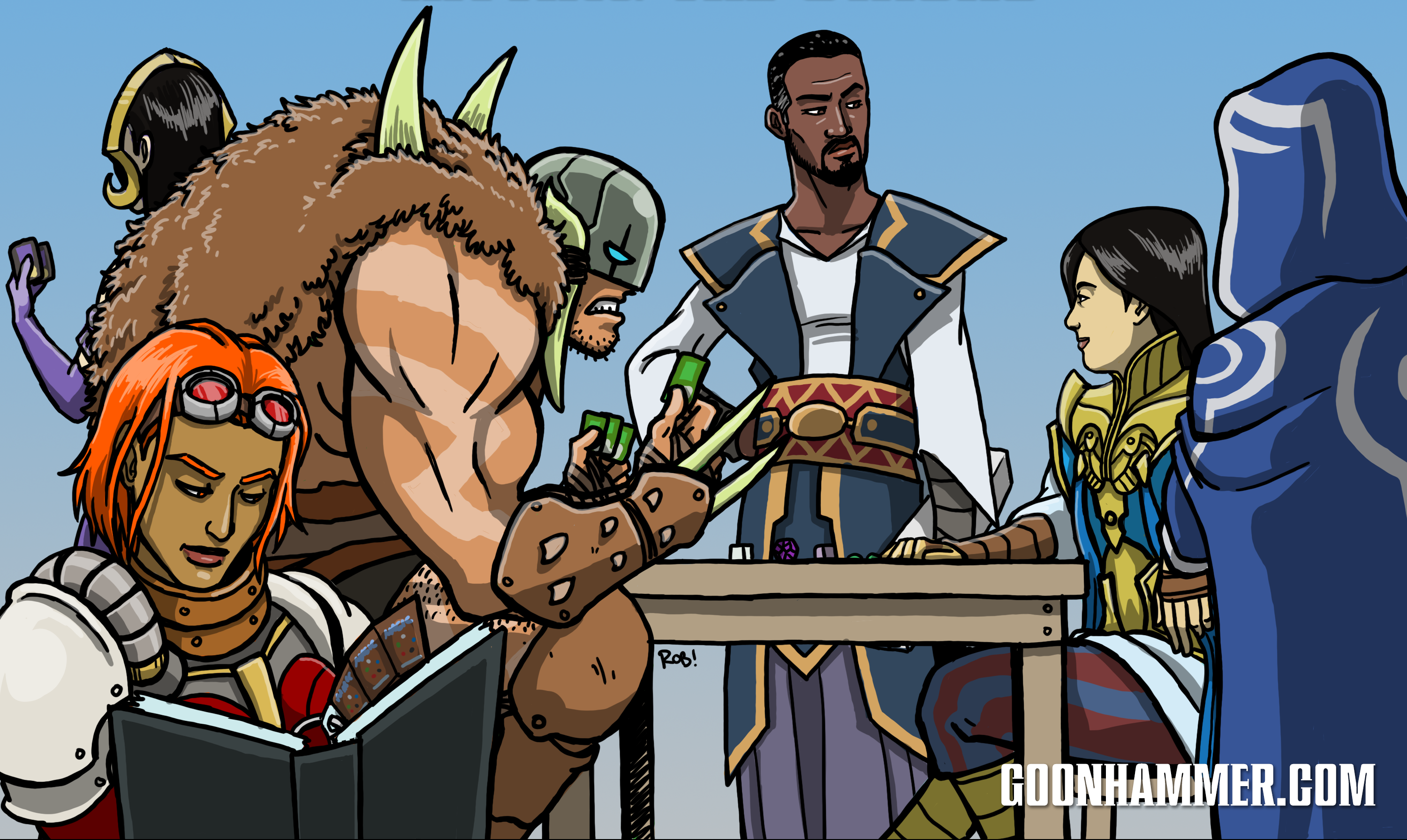The Specter of Defeat is a tri-color Grixis resource management deck built around dropping specters and forcing discards from your opponents hands, then both rewarding yourself for their lack of hand and discards and punishing them. It’s sure to make you super popular at any table, as people love having their pet cards removed from their hands.
Nicol Bolas is like, the archenemy. Except for the Eldrazi. And except for the Phyrexians. They’re dead though, or something, like a building fell on your favorite character. And the Eldrazi are locked up playing with toddlers shapes, or trapped in a moon, so the universe is safe except for Oko who is cut and can turn you into an elk or something.
You know what’s coming, right? It’s a dumb team up. Eldrazi + Bolas or Eldrazi + Phyrexians. And then all 3. Like, the universe will both have never existed and also have been totally corrupted, I guess.
Anyway… Hypnotic Specter was an awesome card, back in the day.

You could turn 1 Swamp, Dark Ritual, drop your Hypnotic Specter and go to town on your opponents hand. We didn’t play good cards back then, so your turn 1 specter would probably cause several discards. Rough. There are also some old cards like Black Vise and The Rack that are not good at all, but this being 1993, the greatest year in gaming, we didn’t know any better and you could theoretically grind your opponent down by messing with their hand size.
There’s quite a few “specter-esque” specters, and some similar effects off of non-specters. In typical Wizards of the Coast fashion, a relatively random assignment of a game mechanic to a creature type in the original set has lead to 30 years of specters that cause discarding. Random discard is pretty powerful though, so it’s quite a rarity. In a game where you take a two land hand, if your opponent plays turn 1 Swamp, Ritual, Specter, then on turn 2 hits you and wipes out your second land randomly, you could be basically taken out of the game; so it’s maybe understandable that forcing your opponent to randomly discard repeatedly has only been printed on something to the tune of around 15-20 specters over the years, along with some specter analogs.
So your basic game plan is to going to be ramping into early mid-game and immediately starting drop specters and support cards. All specters cost a minimum of three mana, ranging up to six, though we’re mostly focused on the three or four CMC variety. To support them is some non-flying board clear, since everything in the deck flies (except like, your little supports like Tinybones, Trinket Thief), a bit of cheap reanimation, some creature control interaction to blow up enemy fliers and reach creatures or threats, and finally some reactive sacrifice spells. Why sacrifice creatures in response? One, these are chosen over defensive counterspells just for power level. This is intended as a semi-fun (because how fun is it to have your hand stripped) but interactable mid-range deck, and also because this deck is really about resource denial. If your opponent tries to cast swords to plowshares on one of your specters, and your response is to cast village rites and sacrifice it, drawing cards in response and effectively countering their spell, that feels bad. That player is down cards, and you’re about even. In game-theory terms it’s not a good exchange for you really, but it’s downright awful for the opponent who targeted you. And generally they won’t want to target your creatures again, to avoid the bad feeling of a reactive sacrifice.
On top of that, if your turn around and then Reanimate the spectre they blew up, that feels super bad.
Since this deck is about resource denial, you generally want to let your opponents develop their board state a little. Let them overextend by dumping all their mana rocks, then start hitting their hand, keeping mana in reserve to use your sacrifices if necessary. Then start bringing in your supports.
These all punish your opponents for discarding or being low on cards:
- Bloodchief Ascension
- Quest for the Nihil Stone
- Megrim
- Liliana’s Caress
- Pain Magnification
- Shrieking Affliction
- Wheel of torture
- Raiders Wake
These cards reward you when your opponent discards:
Your ramp is a standard package of mainly two-cost rocks meant to allow you to drop one on turns two and three. To function, this deck needs enough mana to cast a specter and interact each round, so your deck isn’t really “live” until you’ve got five mana on the board. Hopefully you can pull that on turn four, because you really should expect your opponents to blow up your specters, and you want to be able to react with a sacrifice, depending on how unfriendly and defensive your meta is.
Your commander is basically there for theme and colors. There’s really no perfect commander since there aren’t a lot of legendary specters, just Urgoros, the Empty One, who has a mono-black color identity and is so bad the deck doesn’t even run it (six cost, so, too much). A strong early play is probably to just drop Bolas. He’s a 4/4 flyer that has a really strong enter the battlefield effect. He’ll almost certainly draw some removal. That’s fine; if you can leverage that with a sacrifice, players will assume your commander is critical to your game plan, when he very much isn’t. So early Bolas is a way to draw fire and then be considered non-threatening, while grabbing some card advantage.
Your mana base is more “greedy” than is strictly necessary, since all your creatures cost 1-2 black mana. The deck needs two black mana to function, and then a bit of splash of red and blue. You can almost certainly get by with a single red/blue dual land and the rest black. The deck has one each of spells that cost multiple red and multiple blue.
While this deck technically clocks in at around $640, that is almost all lands, $460 of it is lands, a $33 artifact, $20 commander, $17 Tinybones, $16 Bloodchief Ascension, $8.50 Reanimate. All of these except the commander can be cut for worse versions or basic lands; Tinybones can be replaced with another specter. Even the commander can be cut for Crosis the Purger or even the original Bolas (but probably a reprint since original Legends cards are kind of pricy now). That makes this a very reasonable deck in terms of price.
Have any questions or feedback? Drop us a note in the comments below or email us at contact@goonhammer.com.


